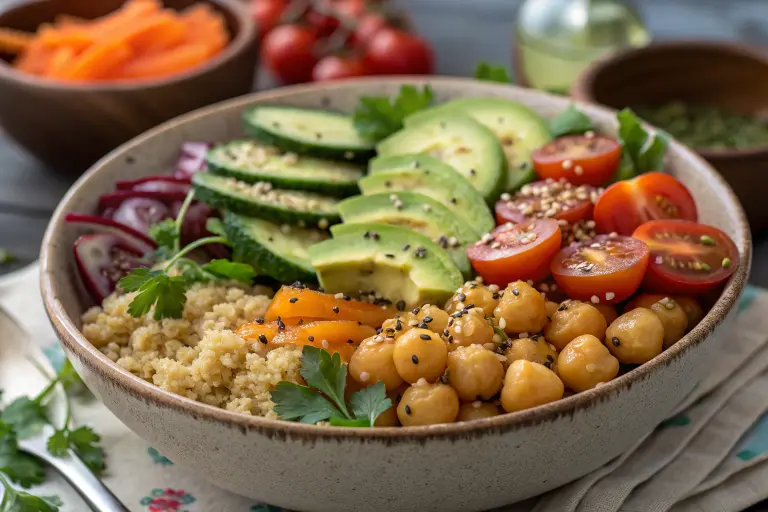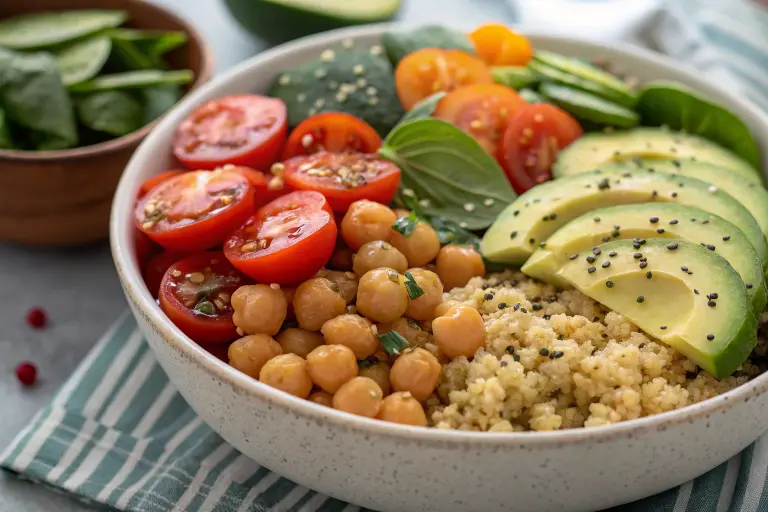In recent years, Buddha bowls have become a popular trend in healthy eating. These vibrant, nutrient-packed meals are often associated with a balanced lifestyle and are as visually appealing as they are delicious. But, as with many food trends, you might have wondered, what is another name for a Buddha bowl? This question often arises when searching for similar dishes or trying to understand the broader culinary movement behind this iconic meal.
This article will provide an in-depth look at Buddha bowls, discover different variations, and answer the question: What is another name for a Buddha bowl? Along the way, we’ll discuss the origin of the dish, its ingredients, and why it’s so popular in the wellness community. Additionally, we’ll touch on related terms and the various ways you can customize it to suit your preferences.
What Is a Buddha Bowl?
Before we answer the question What is another name for a Buddha bowl?, let’s first take a look at what exactly defines a Buddha bowl. Typically, is a hearty, wholesome meal that includes a variety of plant-based ingredients. These ingredients are often arranged in a bowl and served cold or warm, making them an easy and customizable dish for anyone looking to eat more vegetables, grains, and proteins.
The Basic Structure of a Buddha Bowl
A typical contains the following components:
- Base: Usually a grain, such as quinoa, rice, or couscous.
- Vegetables: A mix of raw and cooked vegetables, such as leafy greens, roasted sweet potatoes, or steamed broccoli.
- Proteins: This can include tofu, tempeh, chickpeas, or beans.
- Healthy Fats: Avocados, nuts, or seeds are commonly included to add a source of healthy fats.
- Sauces and Dressings: A flavorful dressing, such as tahini or a lemon-tahini sauce, to tie everything together.
The Popularity of Buddha Bowls
They have surged in popularity due to their versatility, ease of preparation, and alignment with many dietary preferences, including vegetarian, vegan, and gluten-free. These bowls provide a balanced meal that can be easily tailored to fit any taste or nutritional need.
What Is Another Name for a Buddha Bowl?
Now, let’s address the main question: What is another name for a Buddha bowl? The term “Buddha bowl” is often used interchangeably with other names that refer to similar meals. Here are a few variations that are often used:
1. Grain Bowl
A grain bowl is a close cousin to the Buddha bowl, and it emphasizes the use of whole grains as the base. Whether you’re using quinoa, brown rice, or farro, the grain bowl focuses on high-fiber grains paired with various vegetables and proteins. The term “grain bowl” is often used to emphasize the base ingredient.
2. Power Bowl
A power bowl is another term that’s commonly used in place of a Buddha bowl. As the name suggests, these bowls are designed to pack a nutritional punch. Power bowls often contain various vegetables, grains, and protein, all chosen for their high nutrient density. This term is especially popular in fitness circles.
3. Nourish Bowl
A nourish bowl is another term that can be used for a Buddha bowl. This name highlights the dish’s wholesome, nutrient-dense nature. A nourish bowl typically contains various fresh, seasonal ingredients, and the focus is on providing nourishment through whole foods. Like a Buddha bowl, it is perfect for anyone looking for a meal that supports their overall well-being.
4. Macro Bowl
Similar to a Buddha bowl, a macro bowl emphasizes macronutrient balance. It focuses on providing the body with the right amount of protein, fats, and carbohydrates. This name comes from the term “macronutrients,” which refers to the essential nutrients that provide energy. Macro bowls are commonly used by people following specific dietary guidelines that prioritize macronutrient ratios.
5. Veggie Bowl
For those looking to emphasize the vegetable content in their meal, “veggie bowl” is a suitable alternative. This name highlights the fresh vegetables that make up a large portion of the dish. While a veggie bowl may still include grains and proteins, the focus is on the abundance of vegetables.
6. Salad Bowl
In some cases, it’s might be referred to as a salad bowl, especially if the dish is primarily made up of raw vegetables and leafy greens. However, the key distinction is that Buddha bowls typically include a wider range of ingredients, such as grains and proteins, which set them apart from more traditional salads.
The Origins of Buddha Bowls
Buddha bowls, as we know them today, have their roots in the traditional Buddhist monastic practice. Buddhist monks are known for carrying bowls that are filled with whatever food they receive from the community. These bowls often contained a combination of vegetables, grains, and sometimes proteins. Over time, the concept of the Buddha bowl evolved into the vibrant, customizable meals we see today.
The Popularity Surge
The surge in popularity of Buddha bowls in the Western world can be attributed to the growing interest in plant-based diets and sustainable eating. As people increasingly seek out nutrient-dense meals that support their overall health and wellness, Buddha bowls provide an accessible and appealing option. They are especially favored by those following vegetarian, vegan, or gluten-free diets.

How to Build Your Own Buddha Bowl
Now that we’ve answered the question What is another name for a Buddha bowl?, let’s dive into how you can build your own bowl at home. The beauty of Buddha bowls lies in their versatility, allowing you to mix and match ingredients based on your taste preferences and dietary needs.
1. Start with a Base
Your base will typically be a whole grain. Here are some popular options:
- Quinoa: High in protein and gluten-free.
- Brown Rice: A versatile, filling grain.
- Farro: A chewy grain with a nutty flavor.
- Couscous: A lighter option that’s easy to prepare.
2. Add Some Protein
Protein is an essential part of a balanced bowl. Some great options include:
- Tofu: A popular plant-based protein that can be baked, fried, or sautéed.
- Chickpeas: Roasted chickpeas add crunch and protein.
- Tempeh: Fermented soybeans with a firm texture and nutty flavor.
- Grilled Chicken: For those who prefer an omnivorous approach.
3. Incorporate Vegetables
Vegetables form the bulk of a Buddha bowl. You can include a mix of raw and cooked vegetables, such as:
- Roasted Sweet Potatoes
- Kale
- Spinach
- Carrots
- Cucumber
- Broccoli
4. Include Healthy Fats
Adding healthy fats will help you feel satisfied and nourish your body. Consider these options:
- Avocado: A rich, creamy source of healthy fats.
- Nuts and Seeds: Almonds, sunflower seeds, and chia seeds are great choices.
- Olive Oil: Drizzle some olive oil on top for extra flavor.
5. Top with a Flavorful Dressing
It wouldn’t be complete without a dressing to tie all the ingredients together. Some popular options include:
- Tahini Dressing
- Lemon-Tahini Sauce
- Balsamic Vinaigrette
- Miso Dressing
The Benefits of Eating Buddha Bowls
They are more than just a food trend. They offer a variety of health benefits, making them an excellent choice for anyone looking to improve their diet.
1. Nutrient-Dense
They are packed with vitamins, minerals, and antioxidants. The combination of vegetables, grains, and proteins gives you a balanced mix of essential nutrients.
2. Highly Customizable
Whether you follow a specific dietary plan or have particular food preferences, Buddha bowls can be tailored to meet your needs. You can adjust the ingredients based on what’s in season, your favorite flavors, or any dietary restrictions you have.
3. Supports Healthy Digestion
Many Buddha bowls include high-fiber ingredients, such as leafy greens, whole grains, and legumes, which can help promote healthy digestion and maintain gut health.

FAQs: Buddha Bowls and Their Variations
❓What is another name for a Buddha bowl?
Other names for a Buddha bowl include grain bowls, power bowls, nourish bowls, macro bowls, veggie bowls, and salad bowls. These terms highlight different aspects of the dish, but they all follow the same general concept of a nutrient-packed meal in a bowl.
❓Can a Buddha bowl include meat?
Yes, while Buddha bowls are often plant-based, they can include meat such as grilled chicken or turkey, depending on your dietary preferences.
❓Are Buddha bowls suitable for a vegan diet?
Absolutely! Buddha bowls are highly customizable and can easily be made vegan by using plant-based proteins like tofu, tempeh, or chickpeas, and avoiding animal-derived ingredients.
❓What is the best base for a Buddha bowl?
Common bases for Buddha bowls include whole grains like quinoa, brown rice, farro, or couscous. These grains provide a solid foundation for the dish.
❓Can I prepare a Buddha bowl in advance?
Yes, Buddha bowls can be prepared ahead of time. Just store the ingredients separately and assemble them when you’re ready to eat. Keep dressings on the side to prevent sogginess.
Conclusion: Buddha Bowls and Their Many Names
In conclusion, what is another name for a Buddha bowl? There are various terms that can be used interchangeably, such as grain bowls, power bowls, nourish bowls, macro bowls, veggie bowls, and salad bowls. These names may differ, but they all share the same core concept: a well-balanced meal that includes grains, vegetables, proteins, and healthy fats. They are not just a trend but a nutritious way to nourish your body, offering versatility and flexibility to suit any dietary preference.
They are more than just a meal; they are a blank canvas for creativity in the kitchen. Whether you choose to add your favorite vegetables, experiment with different grains, or explore various plant-based proteins, the possibilities are endless. By focusing on nutrient-dense ingredients, you can create a satisfying meal that supports your overall health and well-being. And, with the numerous variations, you can enjoy different flavor profiles while still reaping the benefits of a balanced, wholesome dish.
If you’re looking for other bowl-based recipes to add to your meal rotation, be sure to check out our Salmon Poke Bowl and Poke Bowl Recipe for delicious and healthy alternatives. These bowls follow a similar concept of a nutrient-rich base with customizable toppings and dressings, making them perfect for anyone who enjoys building their meals with fresh, high-quality ingredients.
For even more recipe inspiration and cooking tips, visit our Chaynez Recipes, where you’ll find links to all of our latest recipes, cooking tutorials, and much more. Enjoy experimenting with new flavors and ingredients, and create meals that make both your body and taste buds happy!






